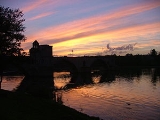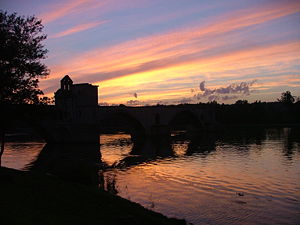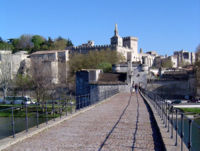
Pont Saint-Bénezet
Encyclopedia
 |
 |
The Pont Saint-Bénezet (pɔ̃ sɛ̃ benezɛ), also known as the Pont d'Avignon (pɔ̃ daviɲɔ̃), is a famous medieval bridge
Bridge
A bridge is a structure built to span physical obstacles such as a body of water, valley, or road, for the purpose of providing passage over the obstacle...
in the town of Avignon
Avignon
Avignon is a French commune in southeastern France in the départment of the Vaucluse bordered by the left bank of the Rhône river. Of the 94,787 inhabitants of the city on 1 January 2010, 12 000 live in the ancient town centre surrounded by its medieval ramparts.Often referred to as the...
, in southern France
France
The French Republic , The French Republic , The French Republic , (commonly known as France , is a unitary semi-presidential republic in Western Europe with several overseas territories and islands located on other continents and in the Indian, Pacific, and Atlantic oceans. Metropolitan France...
.
The bridge originally spanned the Rhône River
Rhône River
The Rhone is one of the major rivers of Europe, rising in Switzerland and running from there through southeastern France. At Arles, near its mouth on the Mediterranean Sea, the river divides into two branches, known as the Great Rhone and the Little Rhone...
between Avignon and Villeneuve-lès-Avignon
Villeneuve-lès-Avignon
Villeneuve-lès-Avignon is a commune in the Gard department in southern France. It can also be spelled Villeneuve-lez-Avignon.-Population:-Sights:* Chartreuse Notre-Dame-du-val-de-Bénédiction* Fort Saint-André* Tour Philippe Le Bel...
on the left bank. It was built between 1171 and 1185, with an original length of some 900 m (2950 ft), but it suffered frequent collapses during floods and had to be reconstructed several times. Over the centuries, it became increasingly perilous as arches collapsed and were replaced by rickety wooden sections.
The bridge was finally put out of use by a catastrophic flood in 1668, which swept away much of the structure. It was subsequently abandoned and no more attempts were made to repair it. Since then, its surviving arches have successively collapsed or been demolished, and only four of the initial 22 arches remain intact today.
The arches are elliptical, with the long axis vertical. This innovation in bridge building allowed spans of up to 35 meters, longer than any Roman arch spans. This, along with the novel use of cutwaters
Starling (architecture)
In architecture, a starling or, more commonly, cutwater is a defensive bulwark, usually built with pilings or bricks, surrounding the supports of a bridge or similar construction...
that are pointed in both the upstream and the downstream direction, reduced scour
Scour
Scour Inc. was a multimedia search engine on the internet, and provided Scour Exchange, an early peer-to-peer file exchange service. Scour was founded by five students from the Computer Science Department of the University of California, Los Angeles in 1997...
around the pilings
Pile bridge
A pile bridge is a structure that uses foundations consisting of long poles , which are made of wood, concrete or steel and which are hammered into the soft soils beneath the bridge until the end of the pile reaches a hard layer of compacted soil or rock...
, one of the main threats to the stability of stone bridges.
The bridge's construction was inspired by Saint Bénézet, a local shepherd boy who (according to tradition) was commanded by angels to build a bridge across the river. Although he was ridiculed at first, he dramatically "proved" his divine inspiration by miraculously lifting a huge block of stone. He won support for his project from wealthy sponsors who formed themselves into a Bridge Brotherhood to fund its construction. After his death, he was interred on the bridge itself, in a small chapel standing on one of the bridge's surviving piers on the Avignon side.
The bridge was also the site of devotion by the Rhône boatmen, whose patron saint was Saint Nicholas
Saint Nicholas
Saint Nicholas , also called Nikolaos of Myra, was a historic 4th-century saint and Greek Bishop of Myra . Because of the many miracles attributed to his intercession, he is also known as Nikolaos the Wonderworker...
. They initially worshipped in the Chapel of Saint Nicholas on the bridge itself (where Saint Bénézet's body was also interred) but the increasing dilapidation of the bridge led to the clergy refusing to preside over services for fear of a total collapse. A new chapel was erected on dry land in the 18th century at the foot of the bridge, on the Avignon side.
The bridge had great strategic importance as the only fixed river crossing between Lyon
Lyon
Lyon , is a city in east-central France in the Rhône-Alpes region, situated between Paris and Marseille. Lyon is located at from Paris, from Marseille, from Geneva, from Turin, and from Barcelona. The residents of the city are called Lyonnais....
and the Mediterranean Sea
Mediterranean Sea
The Mediterranean Sea is a sea connected to the Atlantic Ocean surrounded by the Mediterranean region and almost completely enclosed by land: on the north by Anatolia and Europe, on the south by North Africa, and on the east by the Levant...
. It also formed the only river crossing between the Comtat Venaissin
Comtat Venaissin
The Comtat Venaissin, often called the Comtat for short , is the former name of the region around the city of Avignon in what is now the Provence-Alpes-Côte d'Azur region of France. It comprised roughly the area between the Rhône, the Durance and Mont Ventoux, with a small exclave located to the...
, an enclave controlled by the Pope
Pope
The Pope is the Bishop of Rome, a position that makes him the leader of the worldwide Catholic Church . In the Catholic Church, the Pope is regarded as the successor of Saint Peter, the Apostle...
, and France proper under the authority of the Kings of France. As such, it was closely guarded on both sides of the river. The left bank, which was controlled by the French crown, was overlooked by the formidable fortress of the Tour Phillippe le Bel and the citadel at Villeneuve-les-Avignon. On the Avignon side, the bridge passed through a large gatehouse erected in the 14th century (with major modifications in the 15th century), passing through and over the city wall and exiting via a ramp (now destroyed) which led into the city.
The song "Sur le pont d'Avignon"




- Sur le pont d'Avignon
- L'on y danse, l'on y danse
- Sur le pont d'Avignon
- L'on y danse tous en rond
- Les beaux messieurs font comm' ça
- Et puis encore comm' ça
- Sur le pont d'Avignon
- L'on y danse, l'on y danse
- Sur le pont d'Avignon
- L'on y danse tous en rond
- Les bell' dames font comm' ça
- Et puis encore comm' ça
- Sur le pont d'Avignon
- L'on y danse, l'on y danse
- Sur le pont d'Avignon
- L'on y danse tous en rond
- Les jardiniers font comm' ça
- Et puis encore comm' ça
- Sur le pont d'Avignon
- L'on y danse, l'on y danse
- Sur le pont d'Avignon
- L'on y danse tous en rond
- Les couturiers font comm' ça
- Et puis encore comm' ça
- Sur le pont d'Avignon
- L'on y danse, l'on y danse
- Sur le pont d'Avignon
- L'on y danse tous en rond
- Les vignerons font comm' ça
- Et puis encore comm' ça
- Sur le pont d'Avignon
- L'on y danse, l'on y danse
- Sur le pont d'Avignon
- L'on y danse tous en rond
- Les blanchisseus's font comm' ça
- Et puis encore comm' ça
In fact, people probably would have danced beneath the bridge (sous le pont) where it crossed a river island (the Ile de Barthelasse) on its way to Villeneuve. The island was (and still is) a popular recreation spot, where pleasure gardens once stood and folk dancing was a popular pastime for many years. The bridge itself is far too narrow to have accommodated dancers.
The song was originally composed by the 16th century composer Pierre Certon
Pierre Certon
Pierre Certon was a French composer of the Renaissance. He was a representative of the generation after Josquin and Mouton, and was influential in the late development of the French chanson.-Life:...
, though with a very different melody from its present version and under the more accurate title of "Sus le Pont d'Avignon". The modern version only dates from the mid-19th century, when Adolphe Adam
Adolphe Adam
Adolphe Charles Adam was a French composer and music critic. A prolific composer of operas and ballets, he is best known today for his ballets Giselle and Le corsaire , his operas Le postillon de Lonjumeau , Le toréador and Si j'étais roi , and his Christmas...
included it in an 1853 operetta
Operetta
Operetta is a genre of light opera, light in terms both of music and subject matter. It is also closely related, in English-language works, to forms of musical theatre.-Origins:...
entitled l'Auberge Pleine. It was popularised by an 1876 operetta which renamed the song, as currently, "Sur le Pont d'Avignon."

